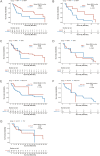Differences of clinical features, prognosis and genetic mutations in Chinese patients with malignant melanoma and additional primary tumours
- PMID: 40317239
- PMCID: PMC12051608
- DOI: 10.1080/07853890.2025.2493769
Differences of clinical features, prognosis and genetic mutations in Chinese patients with malignant melanoma and additional primary tumours
Abstract
Background: The differences in the clinical features, prognosis and genetic mutations in Chinese patients with malignant melanoma (MM) and additional primary tumours remain unclear.
Methods: A retrospective analysis was conducted on patients with malignancies in Fujian Cancer Hospital from January 2007 to September 2022, end follow-up in September 2023. Clinical data were gathered, survival analysis was performed, and genetic mutations were detected.
Results: There were 58 of 1223 melanoma patients with melanoma and additional primary tumours, an incidence of 4.74%. Acral MM was the most common subtype (26/58), 23 (39.66%) patients had concomitant digestive tumours. Patients who had MM as their first primary tumour (MMFP) had shorter tumour occurrence intervals (9.93 vs. 57.78 months, p = .008) but longer melanoma survival (MM-OS) than the non-MMFP group (100.43 vs. 18.93 months, p = .015). Patients with cancer family histories were more likely to have pathogenic and likely pathogenic (P/LP) mutations (2/5 vs. 4/25). The somatic BRAF gene mutation was frequently observed in MM tissue (8/19, 42.11%). Three patients had whole-genome doubling and microsatellite instability-high (MSI-H). The COSMIC2 signature 3 was significantly higher in the P/LP group.
Conclusions: The frequency of MM and additional primary tumours is about 5% in Chinese populations. Patients with melanoma diagnosed first have longer melanoma survival. Digestive system tumours were the most concomitant; a digestive examination is advisable, especially for those with an expected overall survival (OS) greater than 10 months. Meanwhile, patient's family cancer history should be followed up in detail, along with completion of germline P/LP mutation and somatic mutation testing, all of which may provide valuable support for further treatment.
Keywords: Multiple primary malignant tumours; epidemiology; genetic mutation; melanoma; prognosis.
Conflict of interest statement
No potential conflict of interest was reported by the author(s).
Figures



Similar articles
-
Clinical Characteristics and Impact on Prognosis of Melanoma Accompanied by Multiple Primary Malignancies: A Retrospective Analysis.Cancer Invest. 2025 May;43(5):305-314. doi: 10.1080/07357907.2025.2507113. Epub 2025 May 23. Cancer Invest. 2025. PMID: 40405688
-
Clinicopathological features and clinical outcomes associated with TP53 and BRAFNon-V600 mutations in cutaneous melanoma patients.Cancer. 2017 Apr 15;123(8):1372-1381. doi: 10.1002/cncr.30463. Epub 2016 Dec 2. Cancer. 2017. PMID: 27911979 Free PMC article.
-
Conjunctival malignant melanoma in Denmark: epidemiology, treatment and prognosis with special emphasis on tumorigenesis and genetic profile.Acta Ophthalmol. 2016 May;94 Thesis 1:1-27. doi: 10.1111/aos.13100. Acta Ophthalmol. 2016. PMID: 27192168
-
Multiple primary melanomas: analysis of 49 cases.Melanoma Res. 1998 Aug;8(4):361-6. doi: 10.1097/00008390-199808000-00010. Melanoma Res. 1998. PMID: 9764812 Review.
-
BRAF mutational status as a prognostic marker for survival in malignant melanoma: a systematic review and meta-analysis.Acta Oncol. 2020 Jul;59(7):833-844. doi: 10.1080/0284186X.2020.1747636. Epub 2020 Apr 14. Acta Oncol. 2020. PMID: 32285732
References
MeSH terms
Substances
Supplementary concepts
LinkOut - more resources
Full Text Sources
Other Literature Sources
Medical
Research Materials
